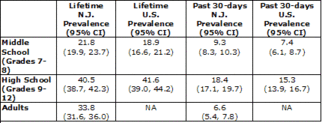In spite of widespread public health initiatives, well-publicized lawsuits, and a growing understanding of the dangers of tobacco use among the public, between 1988 and 1996 the average number of adolescents who tried a cigarette was about 6,000 per day. The number of these first smokers who become daily smokers averages more than 3,000 per day (Centers for Disease Control and Prevention, 1998).
Though there has been an encouraging decline in the national rate of cigarette smoking among youths since 1998, alternative forms of tobacco, such as cigars, have experienced increased popularity (Delnevo, Pevzner, Steinberg, Warren, & Slade, 2002). For example, during that last few years of the 1990s, the media described a rise in cigar use, which was mirrored in the behavior of middle-school and high-school students. This week ASHES reviews research by Delnevo and her colleagues (2002) on adolescent cigar smoking rates in New Jersey and considers the implications of these data for the health of young people.
Drawing on information from the 1999 New Jersey Youth Tobacco Survey and 1999 National Youth Tobacco Survey, Delnevo et al. conducted secondary data analysis to identify adolescent lifetime and past 30-day cigar smoking rates. The authors analyzed information obtained from youths in grades 7-12.
Students completed surveys while in school. The researchers used a cluster design to identify these students. That is, they first selected schools and then classes within those schools. This strategy yielded state and nationally representative samples of students. To compare adolescent rates to adult rates, the authors identified adult past year and past 30-day cigar smoking rates using the 1998 Behavioral Risk Factor Surveillance System. The data on adult cigar smoking rates were restricted to New Jersey; in addition the adult data was weighted from the randomly dialed telephone survey to represent the state population. The adult and adolescent surveys used similar definitions of current/past 30-day use and lifetime/past year use.

Figure. Ever and Current Cigar Use by Middle-School Students, High-School Students and Adults in New Jersey and the United States (adapted from Delnevo et al., 2002). Click image to enlarge.
Note: CI=Confidence Interval.
As the Figure indicates, high school adolescents in New Jersey reported more lifetime cigar smoking than adults. Furthermore, both middle school and high school students reported more past 30-day cigar smoking than adults.
The authors correctly caution that the surveys are susceptible to self-report biases: they suggest it is possible that youth overestimate and adults underestimate their cigar smoking rates. Future research might consider using biological markers (e.g., cotinine blood levels) to confirm reports of current smoking or “bogus pipeline” designs to increase the integrity of self-report. It also would be interesting to report prevalence rates by grade to gain additional information about the age of cigar smoking initiation. Additionally, reporting prevalence rates by age could help design appropriate primary prevention programs.
The authors suggest that cigar marketing and advertising strategies, amplified in the 1990s, has “normalized” cigar use; in addition, this process of normalization might also have created a perception of moderate cigar smoking as relatively harmless (Delnevo et al., 2002). This assumption creates a relaxed view of cigar smoking, which overlooks the reality that even moderate use might increase a person’s risk of developing nicotine dependence—cigars have a higher nicotine content than cigarettes—and more lethal disorders like oral, oropharyngeal, and laryngeal cancers.
This study reports that rates of youth cigar smoking often exceed rates of adult cigar smoking. This circumstance could predispose young people to nicotine dependence and, consequently, an earlier onset of a variety of health problems related to tobacco use. It is encouraging to note that since the time this data was collected, national estimates of past 30-day cigar use among middle-school students dropped from 7.4% in 1999 to 7.1% in 2000 and to 6.0% in 2002; among high school students the national past 30-day cigar use dropped from 15.3% in 1999 to 14.8% in 2000 and to 11.6% in 2002 (Centers for Disease Control and Prevention, 2003). Whether these shifting trends signal the end of a cigar-fad or show the effectiveness of prevention programs, we do not know. Nonetheless, these trends do illustrate the continuing need for comprehensive primary prevention programs specifically targeted at youths.
–Siri Odegaard.
References
Centers for Disease Control and Prevention. (1998). Incidence of initiation of cigarette smoking-United States, 19651996. Morbidity and Mortality Weekly Report, 47(39), 837-840.
Centers for Disease Control and Prevention. (2003). Tobacco use among middle and high school students: United States, 2002. Morbidity and Mortality Weekly Report, 52(45), 1096-1098.
Delnevo, C. D., Pevzner, E. S., Steinberg, M. B., Warren, C. W., & Slade, J. (2002). Cigar use in New Jersey among adolescents and adults. American Journal of Public Health, 92(6), 943-945.
What do you think? Please use the comment link below to provide feedback on this article.




